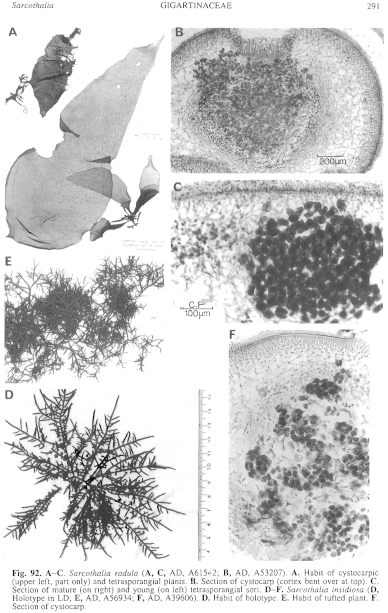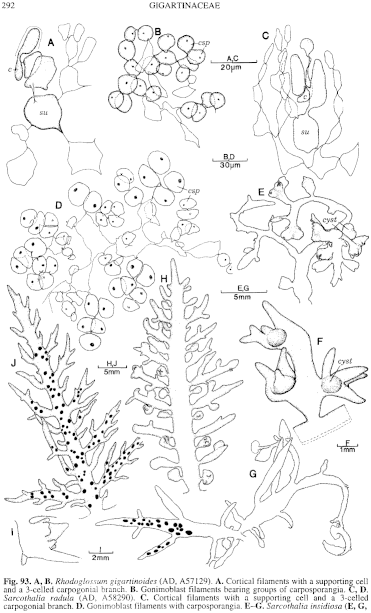|
|
|
|
|
|||||||||||
|
Electronic Flora of South Australia Species Fact Sheet
Phylum Rhodophyta – Class Florideophyceae – Order Gigartinales – Family Gigartinaceae
Synonyms
Fucus radula Esper 1802: 3, pl. 113.
Sphaerococcus radula (Esper) C. Agardh 1822: 268.
Gigartina radula (Esper) J. Agardh 1848: 10; 1851: 278; 1876: 202; 1899: 28. Fuhrer et al. 1981: pl. 22. Harvey 1863, synop.: xliii. Parkinson 1981: 21. Setchell & Gardner 1933: 296.
Gigartina gigantea J. Agardh 1885: 31; 1899: 37, 42. Lucas & Perrin 1947: 152. Setchell & Gardner 1933: 296.
Iridaea gigantea J. Agardh 1899: 42. May 1965: 403. Parkinson 1981: 18. [NON I. gigantea Kützing 1843: 396 from the Atlantic Ocean?]
Iridaea australasica J. Agardh 1892: 60. Kim 1976: 47. May 1965: 404.
Iridophycus australasica (J. Agardh) Lucas & Perrin 1947: 149.
Gigartina nitens J. Agardh 1899: 40. Setchell & Gardner 1933: 296.
Thallus (Fig. 92A) dark red to brown-red, foliose, erect but often decumbent, 15–40 cm long, drying cartilaginous, fronds simple or with 1–3 branches from the short (2–8 mm long) stipe, 5–20 cm broad, expanding gradually from the stipe, lanceolate when young, ovate and tapering or broad apically when mature, occasionally with elongate laterals to 10 cm long from the lower margins. Surface and margin with short spinous papillae 1–2 mm long, occasionally with leaflets 7–10 mm long and 1–2 mm broad, usually with a bare intramarginal zone; margin usually sinuate, entire when young, ciliate to dentate in some plants. Holdfast discoid, 1–3 mm across; epilithic. Structure of a compact cortex of anticlinal, subdichotomous, filaments, outer cells (1–) 2–3 µm in diameter and UD (1–) 1.5–2, and a medulla of (at first) slender anastomosing filaments, 3–5 µm in diameter, later becoming 8-H pm in diameter.
Reproduction: Sexual plants dioecious. Procarps grouped near tips of young papillae, carpogonial branches (Fig. 93C) 3-celled, borne on a relatively large inner cortical (supporting) cell. Cystocarpic papillae simple or branched, 2–3 mm long and 1–3 mm in basal diameter, capitate to clavate with a single (rarely 2 or 3) cystocarp, occurring on both sides of thallus but not opposite each other, covering the fronds apart from a sterile intramarginal zone 3–5 mm wide. Cystocarps (Fig. 92B) with diffuse enveloping tissue of ovoid to elongate cells without transverse filaments from the gonimoblast, a thick cortex with a distinct depression outside the carposporophyte, and a filamentous carposporophyte matrix with scattered larger cells with many pit-connections and numerous small clusters (Fig. 93D) of ovoid carposporangia each 5–10 µm in diameter, liberated by disintegration of
Tetrasporangial sori (Fig. 92C) immersed deep within the medulla, scattered, maculate, single or in groups of 2–5, often in depressions when thallus ruffled, with a sterile thallus intramarginal zone 2–4 mm wide; tetrasporangia in short, simple or branched, chains of 1–4, cut off laterally from clusters of inward growing secondary filaments in the mid medulla, ovoid, 18–30 µm in diameter, cruciately divided.
Type from "Australia"; in Herb. Esper, ER? (not in BM).
Selected specimens: Robe, S. Aust., 1 m deep on slipway reef (Steer, 16.i.1974; AD, A44663) and drift (Womersley, 11.xii.1969; AD, A34871). Cape Lannes, S. Aust., uppermost sublittoral (Womersley, 16.v.1982; AD, A53113) and (Edyvane, 21.vii.1984; AD, A56938). Blackfellows Caves, SE S. Aust., 0–1 m deep, shaded (Womersley, 8.xii.1991; AD, A61542 -"Marine Algae of southern Australia" No. 365 and 18.ix.1993; AD, A62995). Port MacDonnell, S. Aust., 1–2 m deep (Edyvane, 5.vi.1982; AD, A53207) and drift (Edyvane, 26.vii.1982; AD, A58290). Bridgewater Bay, Vic., drift (Womersley, 14.iv.1959; AD, A22625). Port Phillip Heads, Vic. (Wilson, 8.ii.1889; MEL, 652106). San Remo (outer beach), Vic., drift (Sinkora A1974, 27.xi.1974; MEL, 504388). Musselroe Bay, Tas. (Perrin, Jan. 1947; AD, A10839). Tesselated Pavement, Eaglehawk Neck, Tas., drift (Wollaston & Mitchell, 1.iii.1964; AD, A27797). Quiet Corner, Adventure Bay, Bruny I., Tas., drift (Shepherd, 16.ii.1972; AD, A41534).
Distribution: New Zealand, South Africa (?).
Robe, S. Aust., to San Remo, Vic., and around Tasmania, uppermost to deeper sublittoral in regions of slight to moderate water movement, mainly on rough-water coast.
Taxonomic notes: The type specimen (in ER?) of S. radula was sent to Esper by Dawson Turner, from the Banks Herbarium. Unfortunately there is no collector or data other than "Neuholland" on the type sheet. Parkinson (1981, p. 22) considered this locality in error and New Zealand the more likely type locality, since the specimen (described in 1802) must have been collected on Cook's first voyage (1768–71) and Cook did not visit SE Australia where S. radula occurs. Six years after Esper's description, Turner (1808, p. 54), in describing Fucus bracteatus Gmelin (based on specimens from S. Africa and the west coast of N. America) referred to "specimens lately brought to England by Mr Brown" (i.e. from Flinders 1801–5 expedition) and referred to "F. radula which is given to the present plant in the Banksian herbarium". However, several other individuals collected in Australia for Banks before 1800, and the type specimen cannot be excluded from Australia on the present evidence, and some Australian specimens agree well with Esper's illustration.
S. radula is variable in form, depending largely on age and the degree of water movement in its habitat.
Gigartina gigantea J. Agardh (1885, p. 31) from Orford, Tasmania (Meredith), lectotype in Herb. Agardh, LD, 23925 (a possible isolectotype in MEL, 652098), is a larger, calm-water, form intermediate between typical S. radula and the very large calm-water form found in south-east Tasmania (e.g. AD, A41534 which when collected measured 90 cm by 110 cm) and which has sparse but longer surface papillae, some like small leaflets.
Iridaea gigantea J. Agardh (1899, p. 42) is represented in Herb. Agardh by several specimens of Meredith from Tasmania, all of which J. Agardh had previously referred to Gigartina gigantea; all appear to be tetrasporangial plants of S. radula. No sheet is named Iridaea gigantea, but LD, 23207 is here designated as lectotype.
Iridaea australasica J. Agardh (1892, p. 60) is based on two collections - one from Tasmania (Meredith), including four small cystocarpic plants and two sterile ones (which may be different), and a single tetrasporangial plant from Port Phillip Heads, Vic. (Wilson,
28.i.1891; Herb. Agardh, LD, 23184). The latter is chosen as lectotype in view of the importance of the tetrasporangial phase. This plant is without surface papillae and has only slight marginal papillae, as is common in tetrasporangial thalli of S. radula, and as J. Agardh noted the tetrasporangial sori are in the central part of the frond (i.e. deep in the medulla).
The folder in LD of Gigartina nitens J. Agardh (1899, p. 40) contains several specimens, all previously named G. gigantea and without G. nitens on the sheets. A specimen from Port Phillip Heads, Vic. (Wilson, 30.i.1883(?); Herb. Agardh, LD, 23939) is selected as lectotype, being a cystocarpic specimen with well-developed surface and marginal papillae, agreeing well with J. Agardh's description. It is indistinguishable from S. radula.
Plants seemingly identical with the Australian ones do occur in New Zealand, and have generally been known as G. circumcincta J. Agardh (1876, p. 202). Other foliose New Zealand species appear distinct in form but need investigating in detail.
References:
AGARDH, C.A. (1822). Species Algarum. Vol. 1, Part 2, pp. 169–398. (Berling: Lund.)
AGARDH, J.G. (1848). Nya alger från Mexico. Öfvers. K. Svenska Vetensk. Akad. Förh. 4(1), 5–17.
AGARDH, J.G. (1851). Species Genera et Ordines Algarum. Vol. 2, Part 1, 1–336 + index. (Gleerup: Lund.)
AGARDH, J.G. (1876). Species Genera et Ordines Algarum. Vol. 3, Part 1 - Epicrisis systematis Floridearum, pp. i-vii, 1–724. (Weigel: Leipzig.)
AGARDH, J.G. (1885). Till algemes systematik. VII. Florideae. Acta Univ. lund. 21, 1–120, Plate 1.
AGARDH, J.G. (1892). Analecta Algologica. Acta Univ. lund. 28, 1–182, Plates 1–3.
AGARDH, J.G. (1899). Analecta Algologica. Cont. V. Acta Univ. lund. 35, 1–160, Plates 1–3.
ESPER, E.J.C. (1802). Icones Fucorum cum characteribus systematicis, synonymic auctorum et descriptionibus novarum specierum. Heft 5, 1–53, Plates 112–135. (Nuremburg.)
FUHRER, B., CHRISTIANSON, I.G., CLAYTON, M.N. & ALLENDER, B.M. (1981). Seaweeds of Australia. (Reed: Sydney.)
HARVEY, W.H. (1863). Phycologia Australica. Vol. 5, Plates 241–300, synop., pp. i-lxxiii. (Reeve: London.)
KÜTZING, F.T. (1843). Phycologia generalis. (Leipzig.)
KIM, D.H. (1976). A study of the development of cystocarps and tetrasporangial sori in Gigartinaceae (Rhodophyta, Gigartinales). Nova Hedwigia 27, 1–146.
LUCAS, A.H.S. & PERRIN, F. (1947). The Seaweeds of South Australia. Part 2. The Red Seaweeds. (Govt Printer: Adelaide.)
MAY, V. (1965). A census and key to the species of Rhodophyceae (red algae) recorded from Australia. Contr. N.S.W. natn. Herb. 3, 349–429.
PARKINSON, P.G. (1981). Remarks on some algal generic names recently proposed for nomenclatural conservation: Halymenia, Grateloupia, Nemastoma and Schizymenia. Taxon 30, 314–318.
SETCHELL, W.A. & GARDNER, N.L. (1933). A preliminary survey of Gigartina, with special reference to its Pacific North American species. Univ. Calif Pubis Bot. 17, 255–340.
The Marine Benthic Flora of Southern Australia Part IIIA complete list of references.
Publication:
Womersley, H.B.S. (14 January, 1994)
The Marine Benthic Flora of Southern Australia
Rhodophyta. Part IIIA, Bangiophyceae and Florideophyceae (to Gigartinales)
Reproduced with permission from The Marine Benthic Flora of Southern Australia Part IIIA 1994, by H.B.S. Womersley. Australian Biological Resources Study, Canberra. Copyright Commonwealth of Australia.
Illustrations in Womersley Part IIIA, 1994: PLATE 4, fig. 2; FIGS 92 A–C, 93C, D.

Plate 4 enlarge
PLATE 4 fig. 1. Tsengia comosa (AD, A61774). fig. 2. Sarcothalia radula (AD, A62995). fig. 3. Gigartina muelleriana at Evans Cave, Cape Lannes, S. Aust. (AD, A62993). fig. 4. Plocamium mertensii at Breaksea I., Albany, W. Aust. (in Murdoch). Photo: J.M. Huisman.

Figure 92 enlarge
Fig. 92. A–C. Sarcothalia radula (A, C, AD, A61542; B, AD, A53207). A. Habit of cystocarpic (upper left, part only) and tetrasporangial plants. B. Section of cystocarp (cortex bent over at top). C. Section of mature (on right) and young (on left) tetrasporangial sori. D—F. Sarcothalia insidiosa (D, Holotype in LD; E, AD, A56934; F, AD, A39606). D. Habit of holotype. E. Habit of tufted plant. F. Section of cystocarp.

Figure 93 enlarge
Fig. 93. A, .B. Rhodoglossum gigartinoides (AD, A57129). A. Cortical filaments with a supporting cell and a 3-celled carpogonial branch. B. Gonimoblast filaments bearing groups of carposporangia. C, D. Sarcothalia radula (AD, A58290). C. Cortical filaments with a supporting cell and a 3-celled carpogonial branch. D. Gonimoblast filaments with carposporangia. E–G. Sarcothalia insidiosa (E, G, AD, A56932; F, AD, A16198). E. Branchlets with cystocarps. F. Cystocarps with involucral pinnules. G. Branchlets with attachment haptera and tetrasporangial sori. H–J. Sarcothalia crassifolia (AD, A55439). H. Branch with cystocarps, I. Cystocarp with involucral ramuli. J. Branch with maculate tetrasporangial sori.

|
Email Contact: State Herbarium of South Australia |

|